The iPhone 6 Review
by Joshua Ho, Brandon Chester, Chris Heinonen & Ryan Smith on September 30, 2014 8:01 AM EST- Posted in
- Smartphones
- Apple
- Mobile
- iPhone 6
GPU Performance
While we don't quite have real games to benchmark against, we do have benchmarks that are reasonably good approximations of games, which heavily stress the GPU. For the most part, this means that we can see the performance of the A8's PowerVR GX6450 GPU but there are some aspects that are CPU-bound, which we'll discuss after the results.
Edit: Before I get into the results, I must caution that Basemark X will have inaccurate on-screen results as the benchmark was made using XCode 5.x in order to keep scores comparable between versions 1.1 and 1.1.1. This doesn't affect the overall score, which is solely calculated based upon off-screen performance.
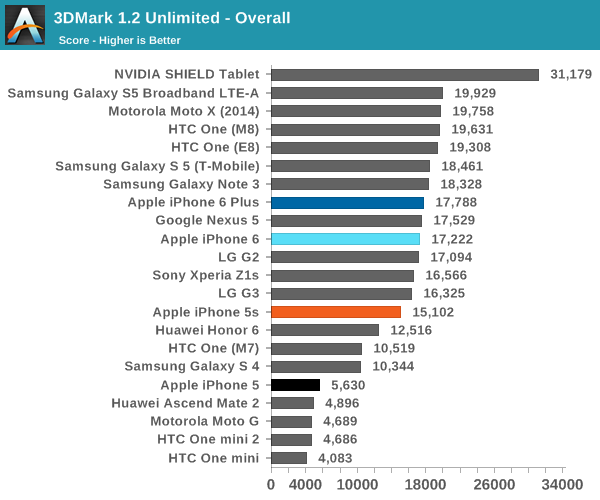
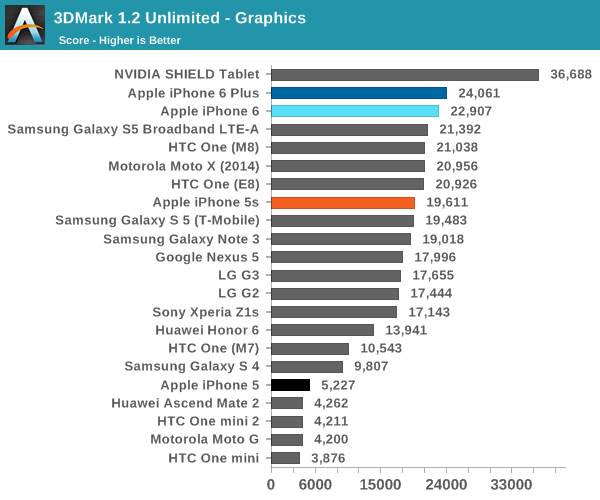
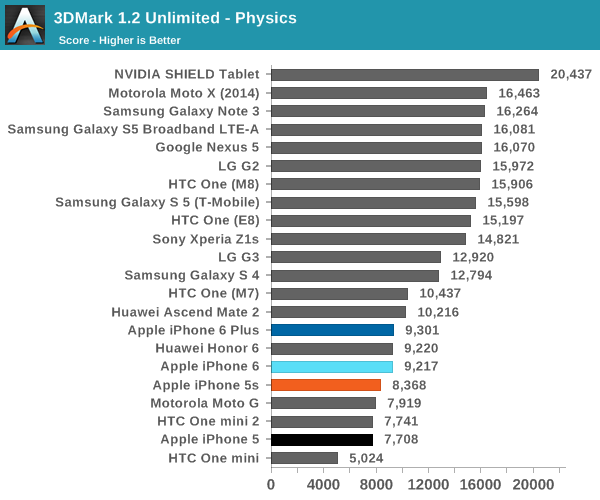
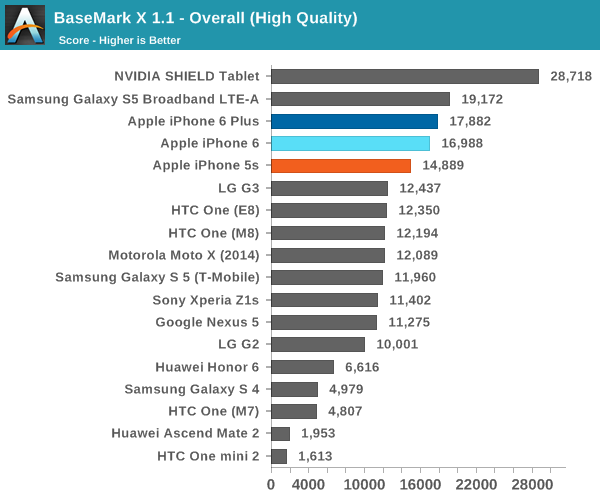

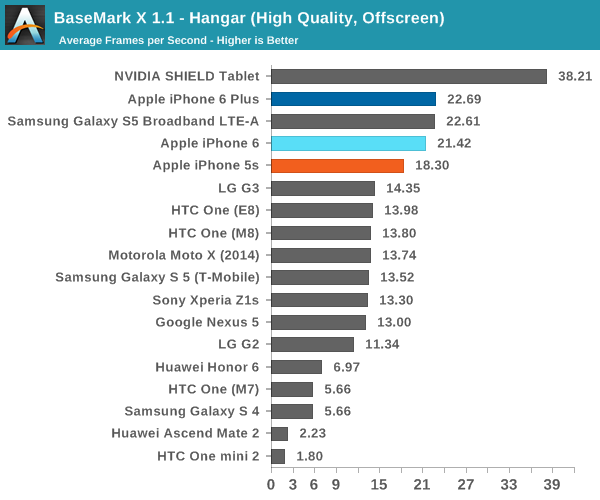

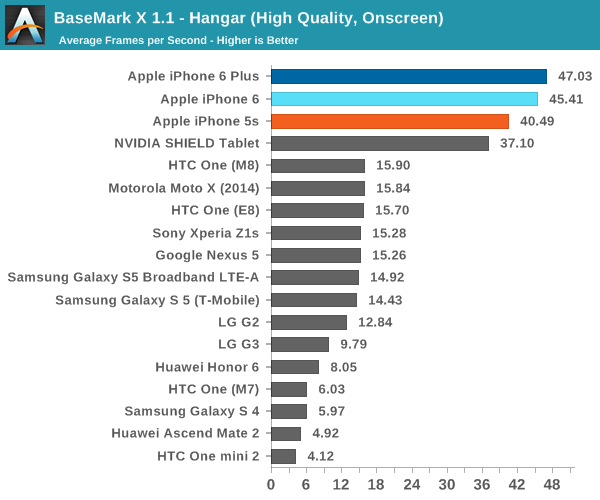
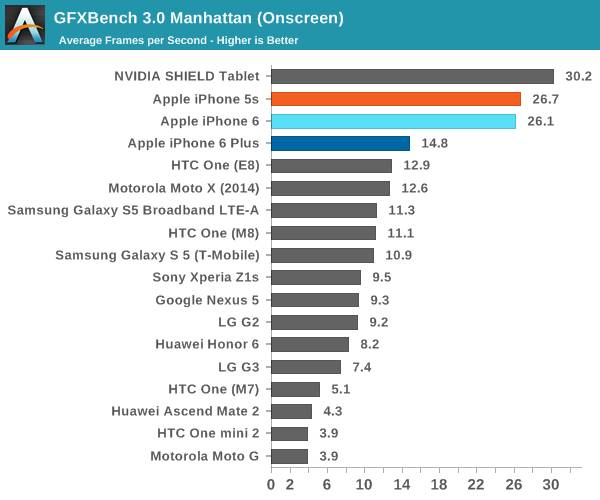


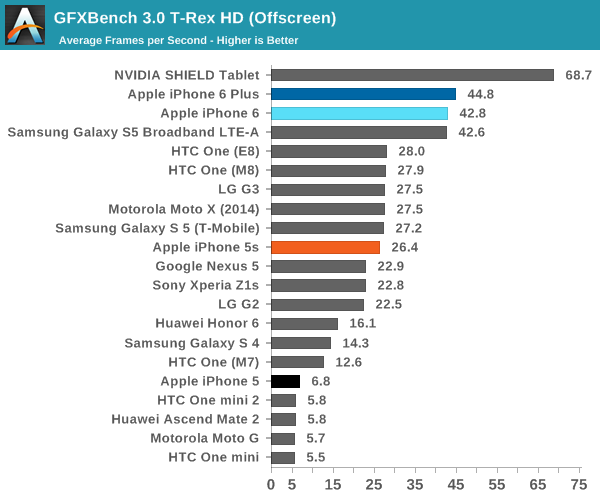
For the most part, we see that the GX6450 is at about the same level as Qualcomm's Adreno 420, which seems to track closely to expectations given that the A7's GPU was around the same performance as the Adreno 330. The 3DMark test does have an interesting result, but it seems that this is because 3DMark's physics test has a strong amount of data dependency that restricts the level of out of order execution that can be done. NVIDIA's Tegra K1 is the current leader in graphics performance, but of course it's also in a tablet instead of a smartphone so it's not a direct competitor.
NAND Performance
As we move towards the goal of seamless performance in everyday tasks, one significant factor is IO performance. While there's definitely a minimum level of performance that allows for generally acceptable smoothness, there's value in having higher storage performance (e.g. prevent bottlenecking in situations such as updating apps in the background). In order to test this, we use Androbench with some custom settings on Android and a custom utility developed by Eric Patno for iOS, who has been quite helpful with furthering our efforts to test storage performance.
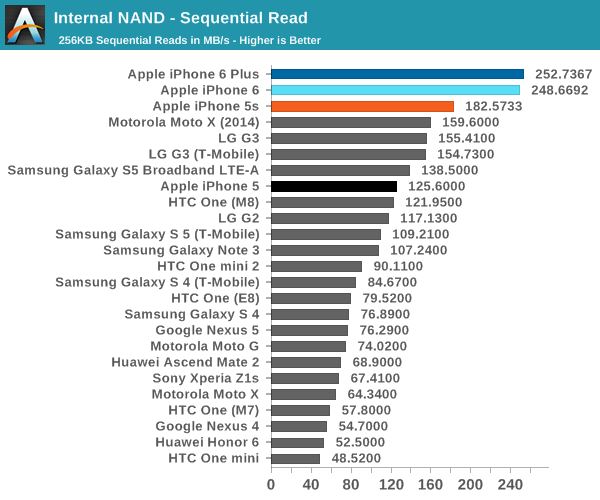
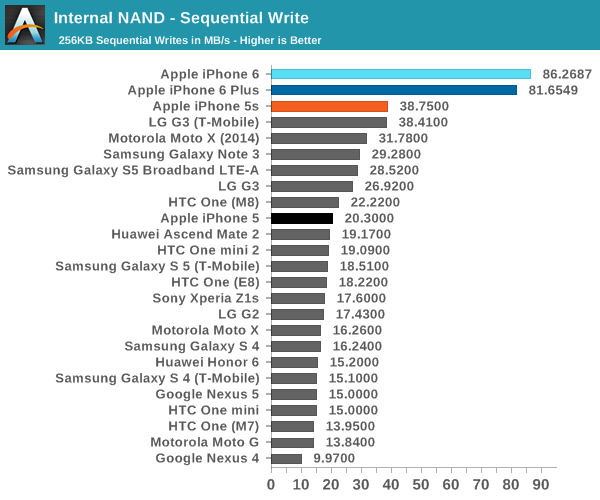
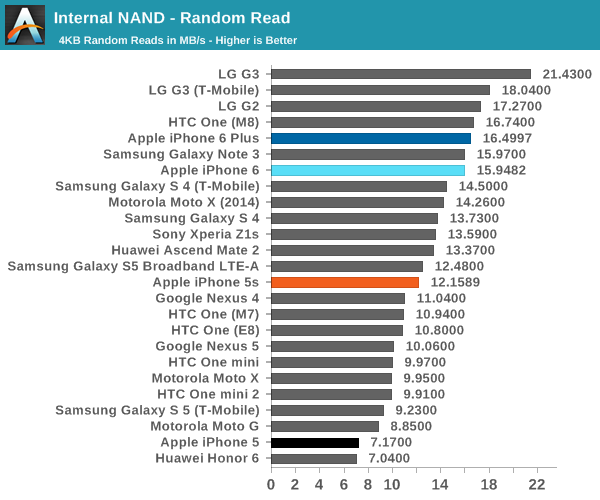
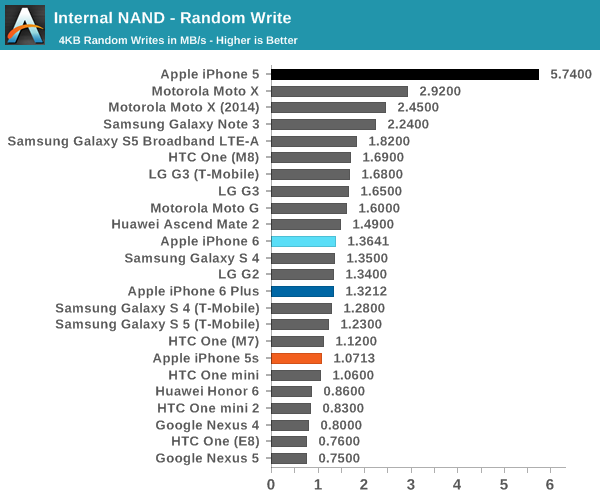
As this is the first time that we've looked into NAND performance on iOS devices, it's definitely worth scrutinizing the data a bit more closely than in most cases. There are a few notable cases here, which are the class-leading speeds for sequential reads and writes on the iPhone 6, but also the rather middling random read and write speeds for the iPhone 6 and 5s. The oddest result is definitely the iPhone 5, which is Ryan's personal unit and while the random read speeds are on the low side, random write speeds are easily record-setting.
In practice, with tablets and smartphones being less multitasking heavy than PCs/laptops, the sequential scores are probably slightly more relevant to the overall user experience. The iPhone 6 results show a significant increase in performance over the iPhone 5s in all of the tests, which is always good to see.










531 Comments
View All Comments
dingodingaling - Thursday, October 2, 2014 - link
1. Is there circumstantial evidence to suggest that AnandTech are Apple Stooges?Yes, absolutely. The founder and owner of the site works for Apple and so does one of their long term “reporters”.
2. Were AnandTech motivated to be Apple Stooges?
Yes, absolutely.
AnandTech are a commercial website, funded by advertising dollars. It is in their interests to drive up traffic and views of their site.
They know that:
a. iPhone users trawl every site that says anything in advance of an iPhone launch to pick up rumours, and after the launch to view “reviews” that help them avoid cognitive dissonance.
b. Apple punish negative reviews by withdrawing access to review devices and invitations to events. http://www.cultofmac.com/255618/how-apples-blackli...
http://www.zdnet.com/blog/apple/apple-prs-dirty-li...
c. Being punished like this will impact them severely from a commercial perspective. They are therefore commercially incentivised to have positive reviews.
3. What means could they use to be Apple Stooges?
Given we know they are motivated and incentivised to give Apple products good reviews, we can analyse how they do it. This can be in 5 basic ways:
a. Use the Apple provided product, not one they brought off the shelf, meaning Apple can tune that one device for tests;
b. Cherry pick tests where the Apple product will do well, and ignore those that they don’t;
c. Carefully select the “comparison” devices, ignoring any that make Apple devices look bad;
d. Make up tests where they think they need to cover up a hole, but ensure that no one else knows how the test works so they can’t repeat it, and
e. Make “mistakes” occasionally and assume no one will notice.
4. Is there evidence to suggest they are using these methods?
a. Use the Apple provided product, not one brought from a store randomly.
Yes we know they do this, and they admit it. Also looking at the Display tests there is evidence to suggest that the Apple provided product was tuned. They themselves had to admit their suspicions.
b. Cherry picking tests.
Yes, they do this.
3DMark Ice Storm
“On the synthetic benchmark 3DMark Ice Storm Unlimited, the iPhone 6 Plus scored 16,965. While that's well above the category average of 13,401, it fell below its Android competition. The S5 blew past with a score of 18,204, as did the HTC One M8 (20,640), the LG G3 (17,548), the OnePlus One (18,399) and the Note 3 (18,321)”
http://www.laptopmag.com/reviews/smartphones/apple...
CNet finds similar results
<image001.jpg>
http://www.cnet.com/products/apple-iphone-6/
An example from Arstechnica
<image002.png>
More results at:
http://results.rightware.com/basemark_x/all-all-ph...
The Stooges select some of their tests (“Basemark X) but not others – why is that??
c. Carefully select the “comparison” devices, ignoring any that make Apple devices look bad;
Yes, they do this.
For the display, the comparisons for max brightness is missing phones for example the Note III which Tom’s hardware measure at 555 Nits. Why the missing phones?? Surely the Stooges have tested these.
One of the missing phones is the Note IV which displaymate tested and rated as the best Smartphone display – and their testing includes both iBends.
“The Best Performing Smartphone or Phablet Display that we have ever tested.”
http://www.displaymate.com/Galaxy_Note4_ShootOut_1...
http://www.displaymate.com/Galaxy_Note4_ShootOut_1...
Suspicious that its missing!
For contrast where are phones like the Galaxy S5? This comparison shows that the S5 has amazing contrast.http://www.phonearena.com/reviews/Apple-iPhone-6-v...
d. Make up tests where they think they need to cover up a hole, but ensure that no one else knows how the test works so they can’t repeat it
Yes, they do this.
For battery Life their test is simply wacko – the only site that has the iBends winning battery life tests and probably due to the rigged nature of the “web browsing” test.
http://gfxbench.com/result.jsp?benchmark=gfx30&...
Tom’s hardware has also has completely different results to the Stooges for battery life and web-browsing http://www.tomsguide.com/us/iphone-6-battery-life,...
Phonearena also have ‘web browsing’ tests that show the iBends aren’t great
http://www.phonearena.com/news/All-bow-to-the-new-...
Arstechnica also found the Ibend battery life to be average.
http://arstechnica.com/apple/2014/09/iphone-6-and-...
e. Make “mistakes” occasionally and assume no one will notice.
Yes, they do this.
Sunspider
The iBend6+ has better measurements than on Tom’s Hardware.
Geekbench 3
The iBend6+ has worse scores on Tom’s hardware than the Galaxy S5 and Note III.
GFXBench 3.0 Manhatten Offscreen
Stooges are rating the IBend6 and iBend6+ higher than GFXBench themselves have tested it at.
http://gfxbench.com/result.jsp
http://laptopmag.com/reviews/smartphones/apple-iph...
The measurement for the iBend6+ is different on Tom’s hardware (its better!), but also different for all the other phones.
More “mistakes” for the colour temperature and gray scale accuracy are completely different in that test as well.
.http://www.phonearena.com/reviews/Apple-iPhone-6-v...
vFunct - Thursday, October 2, 2014 - link
Give it up.Your Android phones area garbage. They're fake iPhones. Apple invented the modern smartphone, and all the innovations like Retina displays. Android keeps trying to copy Apple, but they're never as good or as fast.
Why get a fake iPhone when you can get a real iPhone instead?
Fake iPhones are terrible. Get a real iPhone instead.
KuyaMarkEduard - Sunday, October 5, 2014 - link
Hello Dingodingaling. Are you certain that this practice of Apple is still existing even today, as we speak?""Apple PR's dirty little secret:
Summary: Apple PR maintains a blacklist of journalists that it refuses to talk to. This includes any media outlet that posts anything even remotely negative or heaven help you, a rumor.
Apple's public relations department is notoriously tight-lipped and only responds to a limited subset of the mainstream media, and usually only the outlets that write positive things about its products.
If you dare to write an unflattering piece about Apple or -- heaven forbid -- post a rumor you're almost guaranteed to lose your access to Apple. I know this firsthand because I'm the poster child of Apple's PR blacklist. (I was part of a precedent-setting legal case with Apple in 2005, which I won on appeal in 2007 -- thanks to the Electronic Frontier Foundation.)
Say what you will about my work, but I call 'em like I see 'em.
I write good things about Apple, I write bad things about Apple and I also publish rumors when I believe that they're credible or plausible. I write about things that I find interesting and about topics that will benefit my readers. Sometimes Apple likes what I write other times it doesn't. Apple and I have classic love/hate relationship.
But one thing's for sure, I'm not an Apple cheerleader. If like reading puff pieces about Apple there are a number of websites and blogs that will gladly oblige. Or heck, just dial up apple.com/pr.
Case in point: On February 7 when Arun Thampi posted on his blog that Path was sneakily uploading iPhone user's address books to its server -- without permission -- I called and emailed Apple. Apple didn't reply. Then and I blogged about it.
On February 8 when Dustin Curtis blogged that Apple makes a standard practice of approving apps that upload the entire contents of your iOS address book to developer’s servers I again called and emailed Apple. Apple didn't reply. Then I blogged about it.
Later. Rinse. Repeat.
Then I got an idea. Since Apple PR never responds to my voicemails or emails, maybe they'd respond to the guys that do have access. So I contacted several prominent Apple pundits (who shall remain nameless) that are known for their access to Apple (some of whom get replies from Apple "every time") and I asked them to enquire about Apple's stance on enforcing its policy on address book uploads.
And you know what? None of them would do it.
(Update: ironically there's a couple of exclusive stories out today about Mac OS 10.8/Mountain Lion which certain members of the Mac Illuminati had access to a week early.)
Why? They'd probably say that Apple wouldn't comment. But someone's got to ask if they expect Apple to reply. I mean come on! Apple's not going to press release its shady developers that steal your contacts.
The fact of the matter is that most journos with access to Apple are afraid of losing it. They're afraid of asking the tough questions. They're afraid of getting blacklisted. Like me.
So then I contacted the Wall Street Journal.
There's a prominent columnist at WSJ that has lots of access to Apple. Arguably the most access to Apple. Apple loves the Journal. Apple sends controlled leaks to the Journal. Apple gives unreleased product to the Journal. Surely, Apple would have to respond to the Journal. Right?
Well guess what? Apple spokesman Tom Neumayr replied to AllThings today about the issue of developers stealing your contacts without permission. (More on that later)
Gee? I wonder why?
I'll tell you: AllThingsD is a wholly owned subsidiary of Dow Jones & Company Inc., which is a member of The Wall Street Journal’s Digital Network (which includes WSJ.com, MarketWatch, Barron's, and SmartMoney).
It's simple really. Apple needs the Journal. The Journal doesn't need Apple. And the Journal's not afraid of getting on Apple's PR blacklist -- because it would never happen.
Other wags with access, but without the clout of the Journal are probably afraid of getting blacklisted if they probe around too much -- or ask the tough questions.
My point is that if Apple PR actually read blogs and responded to queries from bloggers things like Address-gate might not explode into giant issues that end up in the Wall Street Journal. Apple could have nipped it in the bud a week sooner by simply replying to my email or voicemail with something to the effect of "yes, we're aware of the issue and we're looking into it."
Instead, Apple makes a conscious point of ignoring certain journalists hoping that unsavory issues like Address-gate blow over and that no one will notice. Well guess what, I'm persistent. And if Apple doesn't reply, I'll contact the people that I know at the Journal -- or my Congressman.
And before you cry "sour grapes!" consider this. I've been blacklisted by Apple for over 10 years. I never get invited, I never get replies. I'm long over it. This doesn't have anything to do with me. It's about you and your privacy. I called and emailed Apple PR because I care about my (and your) private contacts and I wanted to know why Apple isn't enforcing its own privacy policies.
If you don't care about developers stealing your contacts, that's fine. But I do.""
Because if so, with the iBend issue, how can now then we be assured that each and every-time Apple will say a thing about the issue, will always be true, and not fabricated?
This is indeed, an eye-opener to all the Serious tech-readers out-there…, …Of-course, this does-not include the Fanboys.
EricGee - Friday, October 3, 2014 - link
If both new iPhone editions are virtually the same phone, why doesn't the 6 also have landscape view. Both these devices should have an iPad GUI. Landscape view is the most ergonomic position. Having to switch grips from portrait to landscape increases the chance for accidental drops. Landscape also decreases the likelihood for cumulative trauma which include carpal tunnel and digititis. In short, it's just easier to navigate your phone seamlessly by keeping it in your preferred orientation. Lastly, it's sad that I'm waiting for a jailbreak. My plan is not to jailbreak. But if Apple developers can't be aware to what the mass looks for in functionality, jailbreaking may be the only answer. If you would reference Infinidock, this app allows for multiple icons to be docked. Not just four icons. Making these small additions to the user interface would vastly improve the users experience. If developers aren't willing to make such adjustments, then I suggest allowing open code for Cydia jailbreak developers that will allow for users to freely mod our devices.Believe it or not, the ability to freely mod our phones to the users preference is what separates the iPhone and Android users. Hence the jailbreak... Don't patronize your loyal consumers by making such availability this coming S model.
James Wimberley - Friday, October 3, 2014 - link
Anand team: Please consider adding ruggedness tests for mobile devices. Desktops spend their lives in sheltered environments, with a few heatwaves and power cuts and surges. Laptops are occasionally dropped. But tablets and smartphones are constantly being dropped, put in linty pockets, exposed to rain and coffee, bent, scratched, and connected to low-quality chargers. If you a ea SEAL, you need a different order of ruggedness, like the Toughbook. But normal consumer use is still quite deamnding.e34v8 - Friday, October 3, 2014 - link
I have three main complains here.The is the screen resolution. We all know 326 ppi is far, far from enough. I have always been able to see aliasing on iPhone screens (never on my Nexus 5) and aside form that, the image is just not that clear and sharp as on a good 1080p screen. Maybe the 6+ will offer great viewing experience.
The second complain is size. Yes, I think that Apple is making the right move with bigger screen size. Better late than never. The 4.7" are not the ideal size for me, but this is a major improvement. But wtf were Apple thinking, when they made a 4.7" phone, with the dimensions of a 5 or a 5.2"phone? Why? Apple customers value compactness. Just compare it with an old 4.7" phone like the Optimus G - 131.9mm vs 138.1mm .
And last, but not least - 1gb of ram. Are Apple so greedy? This is typical planned obsolescence. I still can't believe it. 64 bit SoC and a gig of ram...
The lack of OIS or wireless charging is also not good.
This phone should cost a lot less.
blackcrayon - Friday, October 3, 2014 - link
"We all know 326 ppi is far, far from enough" - Stopped reading there. It's enough for the vast majority of people, and is certainly a better idea than making a 500 ppi phone that lags.e34v8 - Saturday, October 4, 2014 - link
Well, that's your problem. You should read someone's comment, before you reply.I agree with you. I also hate phones that lag, stutter or miss frames in the UI. That is the reason I do not like Samsung and their Touch Wiz. But that's not the case with my Nexus 5. It's totally stock, but believe me, it's blazing fast and smooth. And it still manages to have a gorgeous 455 ppi screen.
Anyway, there is no such thing as a perfect phone, but Apple could have offered much more, having in mind that it's a flagship expensive device.
michael2k - Monday, October 6, 2014 - link
1) Your eyesight is superior, most aren't nearly as good as yours.2) The Optimus G is 8.45mm thick vs the 6.9mm of the iPhone 6
3) You talk about typical planned obsolescence, yet in the same breath rave about the Nexus 5. The Galaxy Nexus from 2011 won't see either the 2013 KitKat nor the 2014 Android L, whilst the 2011 iPhone 4S saw both the 2013 iOS 7 and the 2014 iOS 8. I would expect a 2014 iPhone 6 to see at least iOS 11, and still be usable! What do you think your 2013 Nexus 5 will see?
4) OIS isn't that important, especially when it already has one of the best cameras in the industry
5) This phone already sold out. Costing less is probably the last thing it needs. Ordered on Sept 20th and expect to see my phone in October 20th.
e34v8 - Thursday, October 9, 2014 - link
The fact that my eyesight is or isn't superior does not change the facts. Ignoring or denying something, without any arguments is not productive. You say that OIS is not important and that's it. Why? I can tell you, I'm never going to buy a phone without OIS again. It's much easier for me to catch perfectly focused shots and shoot steady videos.Anyway, everyone has their own view on things. I think Apple are capable of making a better phone - with thin bezels, full HD screen, more than 1 gig of ram, bigger battery... but they chose not to. I'm not some fanboy that will blindly ignore faults. The iPhone 4 was my last iPhone. I'll continue to wait for something from Apple that's worth the money.